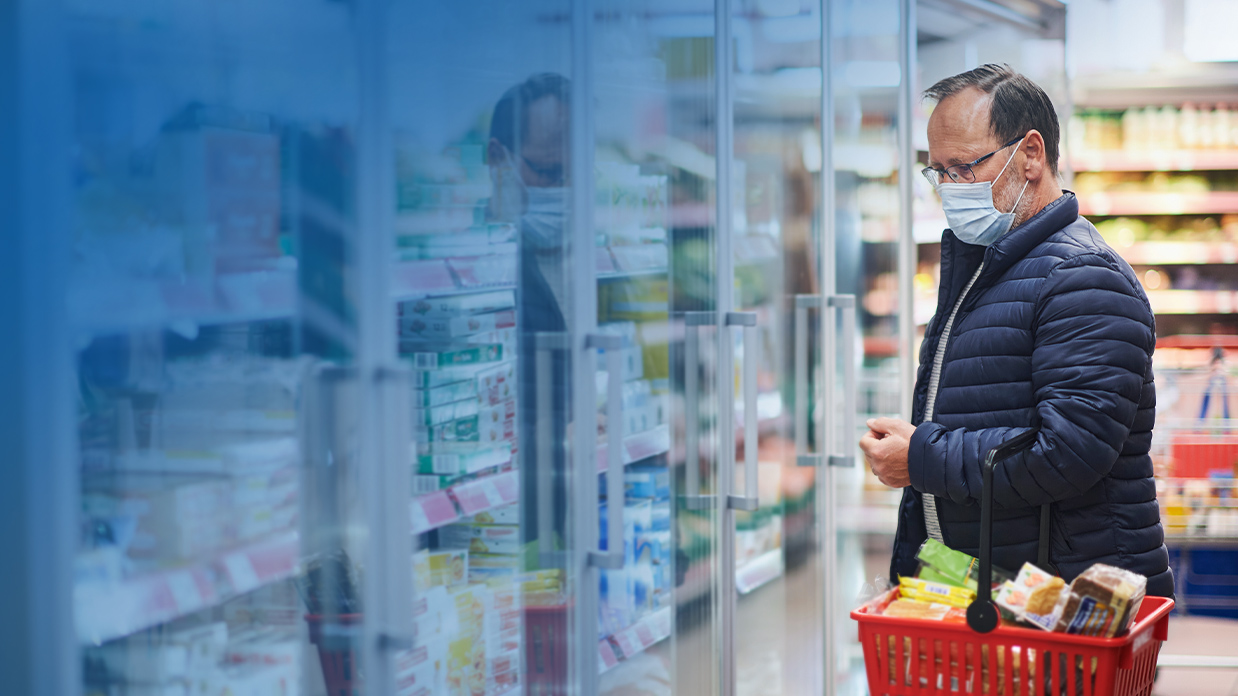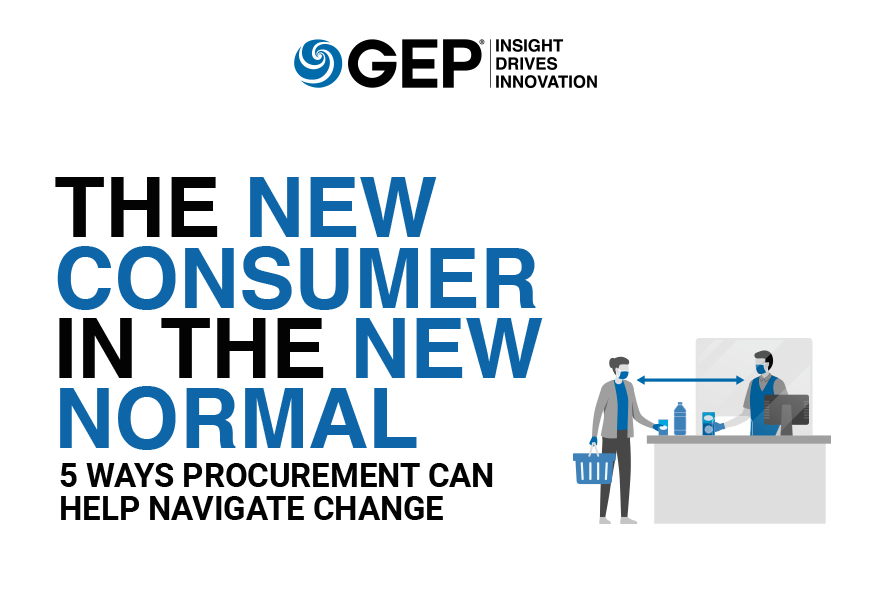The pandemic triggered sudden, significant shifts in consumer behavior. And some of these trends are here to stay.
What are these trends? And what can you — as a procurement pro — do to help your business adapt to this new normal?
A new GEP white paper, The New Consumer in the New Normal: 5 Ways Procurement Can Help Navigate Change, has the answers.
These are the top five areas where enterprises need support from their procurement teams to meet changing consumer expectations and business objectives.
What’s Inside:
- Shifting consumer spending patterns amid the global health crisis
- How leading CPG companies are responding to shifts in market dynamics
- Five key areas where procurement can make a big impact
A must-read for all procurement professionals in the CPG industry who want to strategically help their enterprise cope with change.
The COVID-19 pandemic will continue to fundamentally change the way people think, live and buy. The pandemic has accelerated on-the-horizon technologies and behaviors, creating profound consumer shifts in a matter of weeks and forcing CPG brands and retailers to pivot sharply to transform their business. As consumer spending and consumption habits fluctuate, leaders need to be prepared to fortify omnichannel revenue streams, reprioritize their product assortment, adapt advertising strategies and package sustainably
This white paper examines retail trends, influences on consumer behavior and new buying patterns. It discusses how CPG companies can emerge from this disruption nimbler and stronger than ever before by leveraging their procurement and supply chain teams to navigate these challenges amid strong cost pressures in a post-pandemic world.
HOW SPENDING HABITS HAVE CHANGED
CivicScience’s latest Economic Sentiment Index highlights a 3.1-point rebound to 47.1 in U.S. consumer confidence between July 21 and August 4, the first positive gain since early June.1 It represents a 7-point improvement from the lowest trough in April and a gap of 8.4 points from the pre-COVID-19 peak of 54.5 points in January.
The recent rise in consumer confidence is driven by a decline in the upsurge of COVID-19 infections and raised hopes for the development of a potential vaccine. While this is a positive sign, other economic factors, such as the availability of unemployment benefits and high unemployment claims, will continue to be key factors that influence consumer spending. Walmart’s report of a nearly 5% drop in same-store sales growth in July2 amid the end of stimulus checks and consequent squeezing of disposable income exemplifies the impact of these factors. The consumers’ confidence in their personal finances continues to fluctuate in accordance with the pandemic situation. Here’s how spending habits have changed since the outbreak.
TRENDS IN FOOD AND BEVERAGE
In Q1 2020, food and beverage (F&B) sales grew 75.5% year on year (YoY) globally across retailers, outpacing all other product categories, as consumers stockpiled groceries during the lockdown period.3 Spending on essential goods continued into Q2 in the U.S., and the average household CPG spend from end-March through mid-May remained almost as high as during the panic buying period from early to late March (34-35% above pre-COVID-19 levels).4
Meanwhile, discretionary spending continues to lag well behind pre-COVID-19 levels, exhibiting a hesitant recovery as many American shoppers expect the crisis to continue for the foreseeable future. A category-by-category look at consumer spending in various CPG categories paints an interesting picture:
- Sales in the frozen/refrigerated retail segment have been particularly high, driven by consumers stocking up food products with longer shelf lives to combat uncertainty and limit food waste.
- With consumers spending more time at home, we found that the snacks and comfort food category exhibited a marked increase in sales5, as consumers compensated for the inability to dine out and indulged in snacks during the day.
- Nutritional bars and beverages also saw a fair share of demand as sales for premium nutritional bars, drinks, and snacks rose in Q1, though the closure of gyms saw a sharp fall in powdered supplements. Specifically, we saw consumers increasingly switch to non-carbonated and non-alcoholic beverages because of rising health concerns.
- Traditional cereals and cereal-based snacks, both branded and private labels, did well in Q1; natural and organic brands saw some growth but not at the same rate, which reflects the consumer’s desire for familiar brands and flavors.
- Financial pressure, stockouts, and dining at home have sparked a sudden rise in revenue for small and private label brands over Q1 and Q2. The trend towards generic, lower-priced products during an economic contraction is further exemplified by spikes in demand for smaller and privately labeled brands in the instant potatoes, soups, dry vegetables and frozen food categories.
GROCERY STORES STILL MATTER, BUT E-COMMERCE IS HERE TO STAY
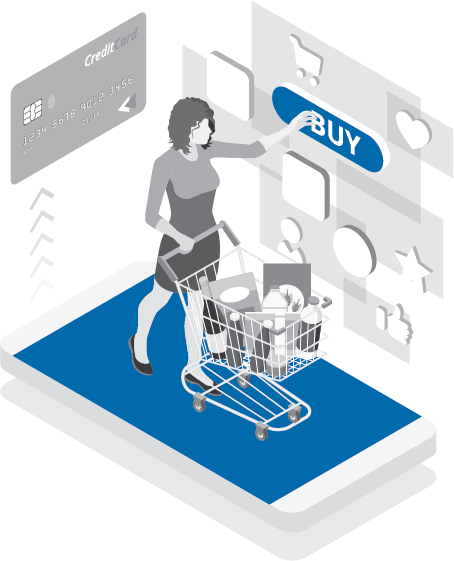
One permanent change spurred by the pandemic is the substantial rise in online shopping and in alternative purchase channels, such as direct delivery (e.g., Amazon), curbside pickup, and third-party on-demand delivery (e.g., Instacart). Although e-commerce has been on the rise for years, lockdowns implemented in late March sparked a 74% YoY increase in Walmart’s online sales6 and record-high downloads for the Walmart grocery app7, followed by 97% growth in Q2. Pure-play e-commerce sales doubled in Q1, a trend that continued in Q2 with Amazon reporting 40% net sales growth and a tripling in online grocery sales YoY.8
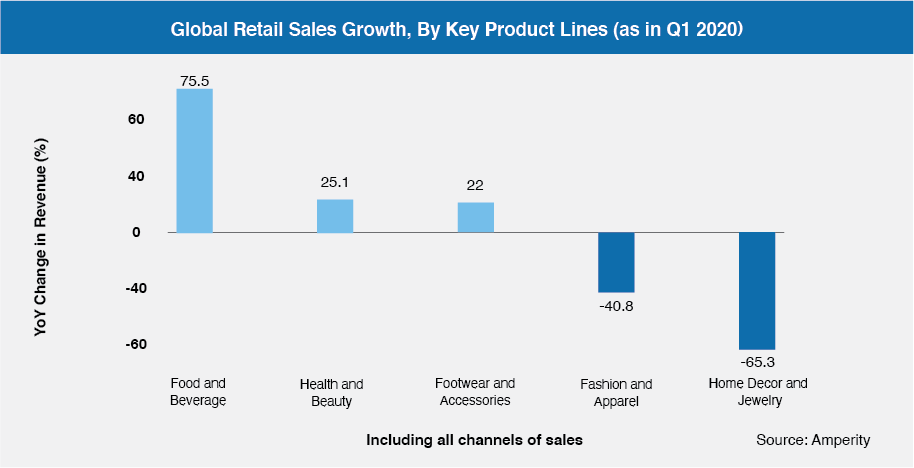
In F&B categories, e-commerce was up 7.2% in Q1 — a strong third place behind gifts and specialty (18.9%), and home and garden (8.4%). These non-food purchases, reflecting a desire for home improvement in response to the lockdown, are frequently one-time buys, so we expect normalization of purchases in these categories. Though the growth of e-commerce has been impressive, significant household penetration opportunities still exist, and e-commerce will continue to gain traction as an integral shopping channel for the F&B category, even as in-store foot traffic bounces back as lockdowns end.
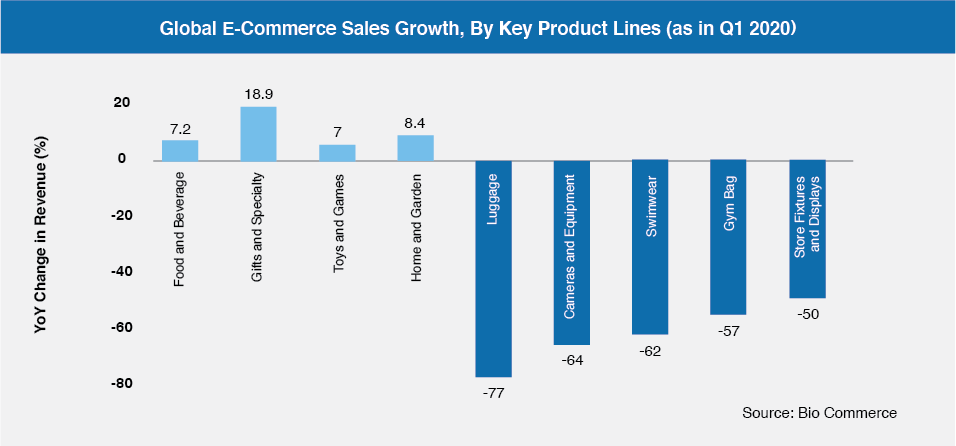
NON-FOOD CPG: CREATIVE SOLUTIONS NEEDED
The health-conscious, price-sensitive consumer, who is socializing less and seeking at-home leisure, is producing ripple effects beyond the F&B category. The beauty and household cleaning product categories have seen huge changes in consumer behavior.
- Cleaning and Personal Hygiene: Heightened sensitivity and standards
Cleaning and personal hygiene segments have benefited the most during the pandemic. Disinfectants and sanitizers surged by 70%9 for Lysol and 33%10 for Clorox based on first half sales growth numbers. This July, Reckitt Benckiser, parent company of Lysol, ramped up its production capacity to manufacture 20 times more volume of sanitizers11 than last year to ensure supply continuity and meet consumer demand.
The demand for cleaning products is not limited to households: It has become essential for building back consumer trust in the hospitality and entertainment industries. Hotels, airlines, rental car companies, and sports arenas announced partnerships with cleaning product makers to not only disinfect their facilities but also to draft new cleaning protocols.12 Hilton’s CleanStay with Lysol Protection, launched in June,13 is an example of a collaboration with CPG companies to promote cleaning standards and earn back consumer trust in public spaces. Once the pandemic passes and hygiene sensitivity normalizes, so too will the frequency at which these purchases are made.
- Beauty and Cosmetics: New patterns and opportunities
The coronavirus has hit the beauty industry quite hard, and global beauty sales are expected to drop by up to 30% in 2020.14 Primary factors fueling this drop include the decrease in socialization, wearing of masks, and closure of brick-and-mortar stores — the purchase of skincare and cosmetic products is often an interactive process, with in-person experimentation and demonstrations key to decision-making.
However, heightened hygiene sensitivity, financial pressure and pandemic-linked stress have also created new opportunities. While consumers are moving away from luxury brands toward value brands, the focus on skincare has accelerated with demand rising for products that have anti-microbial properties, natural ingredients and aid stress relief.15 Plant-based essential oils, along with products containing aloe vera, lemon myrtle, propolis, eucalyptus oil, and tea tree oil, have seen an uptick in demand globally for their antibacterial and antiviral properties.16
At the same time, topical restorative products such as retinol serum, niacinamide serum, and hyaluronic acid, utilized for refining skin tone and texture, are also increasing in popularity, likely because of video calls, on which skin blemishes tend to get highlighted. Increased screen time has also doubled demand for blue-light blocking skincare treatments. Riding the wave of skincare treatments are skincare tools, with some companies reporting almost a doubling of 2019 sales for products like facial steamers and face scrapers.17
This trend is also carrying over to makeup products, where we are seeing a boost in demand for products with skincare benefits, that is, makeup infused with moisturizers, sunscreen and natural oils.18 While the makeup industry has taken a backseat — with lipstick continuing to bear the brunt of the pandemic — consumers are experimenting more with above-the-mask beauty products, spurring a 200% increase in eye makeup sales in Q2.19 At-home hair coloring and DIY manicure kits have also seen demand spikes as consumers remain cautious about visiting public salons.20, 21
RESPONSE TO CONSUMER SHIFTS: RATIONALIZATIONS, BRAND EXTENSIONS AND MORE
As consumers focus on safety, familiarity and comfort, we are seeing significant SKU rationalizations, such as the decision by Mondelez to cut 25% of Oreo varieties and focus on the core brand.22 Additionally, new behaviors such as wearing masks have prompted beauty companies to pivot away from lipstick and focus on eye products.23 If executed correctly, focusing on core SKUs can help meet increased demand, reduce operational complexity and defend market share by pre-empting the trial of competitive products that appeal to current consumer preferences.
At the other end of rationalization is limited brand extension that drives to combine the emotional allure of existing brands with new occasions for comfort eating. Two examples exist in the macaroni and cheese segment — Kraft’s Mac & Cheese Breakfast and the new Cheetos flavor for anytime-in-between meal.24, 25 Both have seen viral content sharing, which reinforces the fundamental resonance of such comfort foods.
In response, CPG advertising spend and strategies are shifting as well. Experiential marketing, such as in-store tasting stations, are unlikely to make a comeback for some time. Couponing and discounting were largely put on hold during the initial COVID-19 stock-ups and panic purchases, as consumption was not rational or price-driven. Many CPGs are indicating a resumption of promotional activity in Q3 focused on digital couponing in place of paper26, and a change in tone from the somber note of Q1.27
Meanwhile, merger and acquisition (M&A) activities have taken a back seat owing to current market uncertainty and focus on meeting current supply chain challenges and consumer needs. According to a multi-industry study conducted by the Harvard Business Review, it is likely that M&A activity will remain low for the remainder of 2020.28 However, interest rates are at a historical low29, and if conditions stabilize soon, there can be a flurry of activity for borrowing capital to execute transactions.
FIVE AREAS WHERE PROCUREMENT CAN MAKE A DIFFERENCE
Consumers are shifting to online buying, but not entirely. They may want familiar meals and comfort food at home, but they are also looking for new things to avoid boredom. Procurement will play a key role in helping their organizations thread the needle and deliver the desired consumer experience. Enterprises will need procurement support in five key areas, with varying levels of impact and complexity based on the organization and the ever-changing landscape of a post-COVID-19 world.
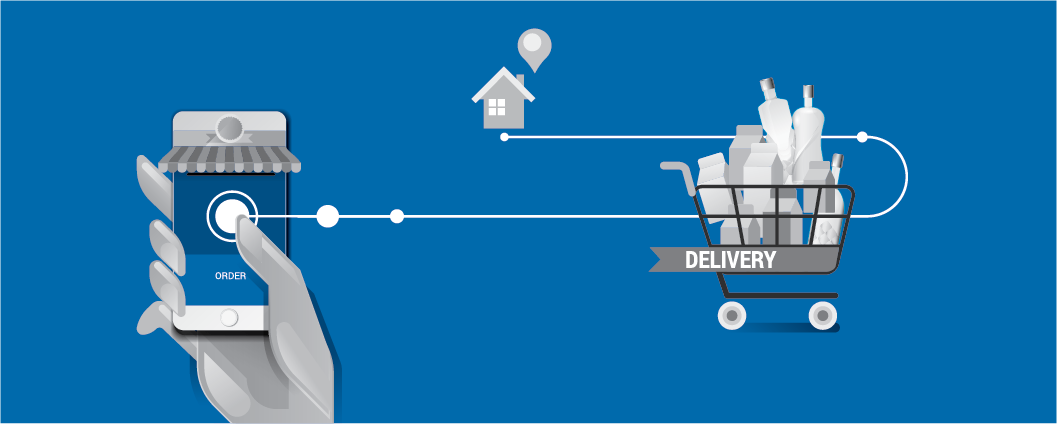
SEEING SPEND, MASTERING COSTS
Procurement must be the gatekeeper for spend in an organization. In an era where you need agility to get a new viral ad out the door while a trend is hot, or to meet new health and safety regulations on the production floor, procurement processes and systems cannot be bottlenecks, else they will be ignored and bypassed. Supplier selection, PO creation, and payables should be digital, easy to use, and rigorously maintained. While companies are working remotely, the requirement that a contract be “walked through the building” for physical signatures is nonsense.
The upside is that the constraints of remote work open the door to the implementation of new digital policies and processes, pushing forward the goal of digital transformation that many organizations have been reluctant to execute. With most transactions (if not all) flowing through a centralized procurement system, advanced analytics can be employed to rapidly identify areas of spend leakage opportunities for negotiation. These tools combine to allow for a unified, enhanced cross-functional communication of business needs, with procurement at the tip of the spear engaging the marketplace for maximum value.
ADAPTING TO NEW NEEDS
As we leave behind the chaos of the initial lockdown period and supply shocks, procurement and supply chain teams are focusing on building robust organizations that can service the new shopping environment. Supply chain executives are evaluating the cost to serve the new product and customer mix, and balancing resources accordingly.
Category owners should look to leverage areas of growth to negotiate favorable rates, even as they work to mitigate rate hikes as a result of reduced requirements. In conjunction with packaging design and manufacturing teams, pack sizes should be evaluated to ensure there is no waste along the new value chain. Similarly, the shift to e-commerce calls for a critical cross-functional endeavor to review designs previously optimized for defending shelf space so that they align with direct-to-consumer (D2C) marketing and shipments. Organizations that can move quickly to determine the needs of the new environment and change their buys accordingly will be the ones that capture the virtual shelf space.
Short-run technologies, such as on-demand boxes and digital label printing, can open up an entire space for customizable D2C packaging that delights customers and sparks significant brand equity. Online shopping offers an additional opportunity to reduce color complexity in printed items to cut cost, utilizing process color or extended gamut in place of brand-specific colors, since these fine distinctions are not visible in most consumer monitors and mobile phone displays. Similarly, professional services such as marketing and customer discovery can be redirected and reprioritized, giving procurement teams the opportunity to engage in driving out wasteful costs and unnecessary scope.
KEEPING SUSTAINABILITY IN SIGHT
It would be a strategic mistake to assume that the past several years’ focus on circular packaging, reduction of single-use plastics, sustainable sourcing of palm oil and similar initiatives were for naught. Instead, a key differentiator in the new normal will be the ability of organizations to resume and accelerate green solutions in product and packaging, alike. The current conditions that have led to resurgence of single-use plastic30 — low oil prices, suspension of local laws on straws and reusable bags, takeout dining — are not representative of the post-COVID-19 world.
So far, CPG companies have not backed off previously communicated sustainability goals31, but if anything, the delay caused by the pandemic will require companies to accelerate and double down to meet these commitments. Procurement and operations teams can utilize this combination of sustainability and omnichannel and e-commerce requirements to redesign packaging with novel materials, reduced weight, and the short-run technologies described earlier.
One example of sustainability-driven change is Campbell’s V8 bottles moving from a full sleeve to a wrap label to make recycling easier for consumers.32 It may be possible to take advantage of new consumer habits developed during the pandemic to execute radical shifts in format, such as moving into closed-loop programs with refillable containers.
BUILDING, OR REBUILDING, BRANDS
While partners in marketing do much of the heavy lifting in brand building and strategy, procurement teams can empower their counterparts by finding suitable external partners, as well as by investigating what peer companies are doing in the marketplace. Beyond bringing the outside in, procurement teams will also have primary responsibility in ensuring that the business terms are meeting the needs of the organization, today and into the future.
Flexibility will be a key attribute and may be worth paying a premium for as it will provide the necessary agility to discover and exploit the new environment. Long-standing contracts with strong partners need not be discarded, but procurement should look to renegotiate terms if an advantageous opportunity exists with agencies looking to re-engage with previously planned spending that was put on hold in Q1/Q2. Renegotiation should focus on minimum spend requirements, volume benefits and multi-year commitments. There is also a window to look internally at the budgeting and forecasting process, and improving cross-functional engagement between marketing, procurement and finance.
DELIVERING OPERATIONAL EFFICIENCY AND AGILITY
As a result of the pandemic itself and its effects on the CPG landscape, manufacturing teams will be looking to procurement for support to meet the needs of leaner supply chains, new capital investment, new sanitization requirements, and management of distribution networks.
As if this wasn’t already a time-consuming demand for procurement, business vulnerabilities identified in March and April are driving requirements to identify secondary and tertiary suppliers — even for categories previously viewed as devoid of risk. In some cases, such backups are readily available, but in others, global supply chains with multiple processing steps must be fully understood and rebuilt from the ground up to entice auxiliary partners with the potential of future business. Strong, proactive teams can take advantage of this opportunity to explore alternatives and drive new technologies or sustainable solutions, while simultaneously creating a more competitive supplier landscape for future sourcing actions.

THE CHANGE HAS ONLY JUST BEGUN
In conclusion, the challenges of 2020 have only just begun. Procurement will be pushed like never before to provide agile responses to a changing environment. Proactive teams will rise to the occasion, propelling their brands to the top of their category or successfully defending them against new challengers. Teams that fail to embrace digital best practices and respond to changing consumer needs will find themselves slipping down the rung of preferred customers, and will struggle to retain leverage with their supplier base.
1. Amie Bolewitz, “ESI: Economic Sentiment Defies Expectation, Sees First Rebound Since Early June,” CivicScience, 5 August 2020. Retrieved 3 September 2020 from https://civicscience.com/economic-sentiment-defies-expectation-sees-firs...
2. Melissa Repko, “Walmart Says Consumer Spending Dropped as Stimulus Checks Ran Out,” CNBC, 18 August 2020. Retrieved 3 September 2020 from https://www.cnbc.com/2020/08/18/walmart-says-consumer-spending-dropped-a...
3. Amperity Staff, “Amperity Retail Monitor Insights Report, Spring 2020” Retrieved 22 September 2020 from https://amperity.com/confirmation-retail-monitor-report-mar-apr
4. Ibid.
5. Ibid.
6. Melissa Repko, “Walmart Second-Quarter Results Crush Estimates, as E-Commerce Sales Jump 97%,” CNBC, 18 August 2020. Retrieved 3 September 2020 from https://www.cnbc.com/2020/08/18/walmart-wmt-q2-2021-earnings.html
7. Sarah Perez, “Walmart Grocery App Sees Record Downloads Amid COVID-19, Surpasses Amazon by 20%,” TechCrunch, 9 April 2020. Retrieved 3 September 2020 from https://techcrunch.com/2020/04/09/walmart-grocery-app-sees-record-downlo...
8. Michael Browne, “Amazon Online Grocery Sales Triple in Second Quarter,” Supermarket News, 31 July 2020. Retrieved 3 September 2020 from https://www.supermarketnews.com/online-retail/amazon-online-grocery-sale...
9. Thomas Buckley, Thomas Mulier and Bloomberg, “Lysol Sales Surge as the Condom Business Goes Limp Under Lockdown, Consumer Goods Giant Reports,” Fortune, 28 July 2020. Retrieved 3 September 2020 from https://fortune.com/2020/07/28/lysol-sales-surge-condom-business-slows/
10. EHS Today Staff, “Clorox Shows Earnings Boost in Wake of COVID-19 Pandemic,” EHS Today, 10 August 2020. Retrieved 3 September 2020 from https://www.ehstoday.com/safety/article/21138705/clorox-shows-earnings-b...
11. Kevin Stankiewicz, “CEO of Lysol Maker Says Sales Are Still up as a Result of Coronavirus Pandemic,” CNBC, 16 July 2020. Retrieved 3 September 2020 from https://www.cnbc.com/2020/07/16/ceo-of-durex-condom-maker-intimate-occas...
12. Hugo Martín, “Hotels, Airlines and Sports Venues Turn To Clorox and Lysol To Vouch for Their Cleanliness,” Los Angeles Times, 12 August 2020. Retrieved 3 September 2020 from https://www.latimes.com/business/story/2020-08-12/covid-19-clorox-lysol-...
13. Juliana, “Hilton Is Partnering With Lysol To Clean Its Hotels,” Trips and Giggles, 20 May 2020. Retrieved 3 September 2020 from https://tripsandgiggles.com/story/hilton-is-partnering-with-lysol-to-cle...
14. Jeanette Settembre, “Coronavirus-Driven Makeup, Beauty Sales Decline Expected To Continue,” Fox Business, 30 June 2020. Retrieved 4 September 2020 from https://www.foxbusiness.com/lifestyle/makeup-beauty-sales-slated-to-cont...
15. Amanda Lim, “Taking on Tea Tree Oil? Antimicrobial Properties of MāNuka Oil Expected To Raise Its Profile in Cosmetics Post-Pandemic,” Cosmeticsdesign-asia.com, 18 August 2020. Retrieved 4 September 2020 from https://www.cosmeticsdesign-asia.com/Article/2020/08/18/Antimicrobial-pr...
16. Premium Beauty News, “Natural Cosmetic Ingredients To Gain Popularity in Post-COVID-19 Era,” Premiumbeautynews.com, 1 June 2020. Retrieved 4 September 2020 from https://www.premiumbeautynews.com/en/natural-cosmetic-ingredients-to,16748
17. Jessica Schiffer, “The Beauty Trends Customers Are Buying During COVID-19,” Vogue Business, 12 August 2020. Retrieved 4 September 2020 from https://www.voguebusiness.com/beauty/the-beauty-trends-customers-are-buy...
18. Parija Kavilanz, “Makeup Sales Take a Hit as Interests Shift in the Work-From-Home Era,” CNN Business, 9 May 2020. Retrieved 4 September 2020 from https://edition.cnn.com/2020/05/09/business/makeup-sales-decline-coronav...
19. Bethany Biron, “Masks May Be Causing a Blow To Lipstick Sales, but Eye Makeup Sales Are Booming as Americans Find Creative Ways To Use Cosmetics,” Business Insider, 11 August 2020. Retrieved 4 September 2020 from https://www.businessinsider.in/retail/news/masks-may-be-causing-a-blow-to-lipstick-sales-but-eye-makeup-sales-are-booming-as-americans-fin-d-creative-ways-to-use-cosmetics/articleshow/77485549.cms
20. Parija Kavilanz, “Makeup Sales Take a Hit as Interests Shift in the Work-From-Home Era,” CNN Business, 9 May 2020. Retrieved 4 September 2020 from https://edition.cnn.com/2020/05/09/business/makeup-sales-decline-coronav...
21. Jessica Schiffer, “The Beauty Trends Customers Are Buying During COVID-19,” Vogue Business, 12 August 2020. Retrieved 4 September 2020 from https://www.voguebusiness.com/beauty/the-beauty-trends-customers-are-buy...
22. Crain’s Chicago Business, “Mondelez Plans To Kill 1 of Every 4 Products,” Chicagobusiness.com, 10 July 2020. Retrieved 4 September 2020 from https://www.chicagobusiness.com/manufacturing/mondelez-plans-kill-1-ever...
23. Bethany Biron, “Masks May Be Causing a Blow To Lipstick Sales, but Eye Makeup Sales Are Booming as Americans Find Creative Ways To Use Cosmetics,” Business Insider, 11 August 2020. Retrieved 4 September 2020 from https://www.businessinsider.in/retail/news/masks-may-be-causing-a-blow-t...
24. “It’s Official: Kraft Mac & Cheese is Approved for Breakfast,” Kraft Heinz, 4 August 2020. Retrieved 4 September 2020 from https://news.kraftheinzcompany.com/press-releases-details/2020/Its-Offic...
25. Cheetos® Mac 'n Cheese Bold & Cheesy https://www.cheetos.com/products/cheetos-mac-n-cheese-bold-cheesy
26. Joe Mandese, “Ad Execs: Recovery to Start in Q3, Budgets to Remain Highly Flexible,” Media Daily News, 7 May 2020. Retrieved 4 September 2020 from https://www.mediapost.com/publications/article/351118/ad-execs-recovery-...
27. Sheila Dang, “It’s Okay to Laugh Again: Advertisers Prepare for Post-Coronavirus Economy,” Reuters, 4 May 2020. Retrieved 4 September 2020 from https://www.reuters.com/article/us-health-coronavirus-advertising-idUSKB...
28. Mark Herndon and John Bender, “What M&A Looks Like During the Pandemic,” Harvard Business Review, 10 June 2020. Retrieved 4 September 2020 from https://hbr.org/2020/06/what-ma-looks-like-during-the-pandemic
29. Jeanna Smialek, “Fed Chair Sets Stage for Longer Periods of Lower Rates,” The New York Times, 27 August 2020. Retrieved 4 September 2020 from https://www.nytimes.com/2020/08/27/business/economy/federal-reserve-infl...
30. Judith Evans, Michael Pooler and Leslie Hook, “Pandemic Sets Back Fight Against Single-Use Plastic,” Financial Times, 31 May 2020. Retrieved 16 September 2020 from https://www.ft.com/content/c479a718-36a6-48e2-8632-a77290fc223a
31. “Unilever Announces Ambitious New Commitments for a Waste-Free World,” Unilever, 7 October 2019. Retrieved 4 September 2020 from https://www.unilever.com/news/press-releases/2019/unilever-announces-amb...
32. “Improving Packaging Recyclability One Label at a Time,” Campbell Soup Company, 13 August 2020. Retrieved 4 September 2020 from https://www.campbellsoupcompany.com/newsroom/news/2020/08/13/improving-p...
